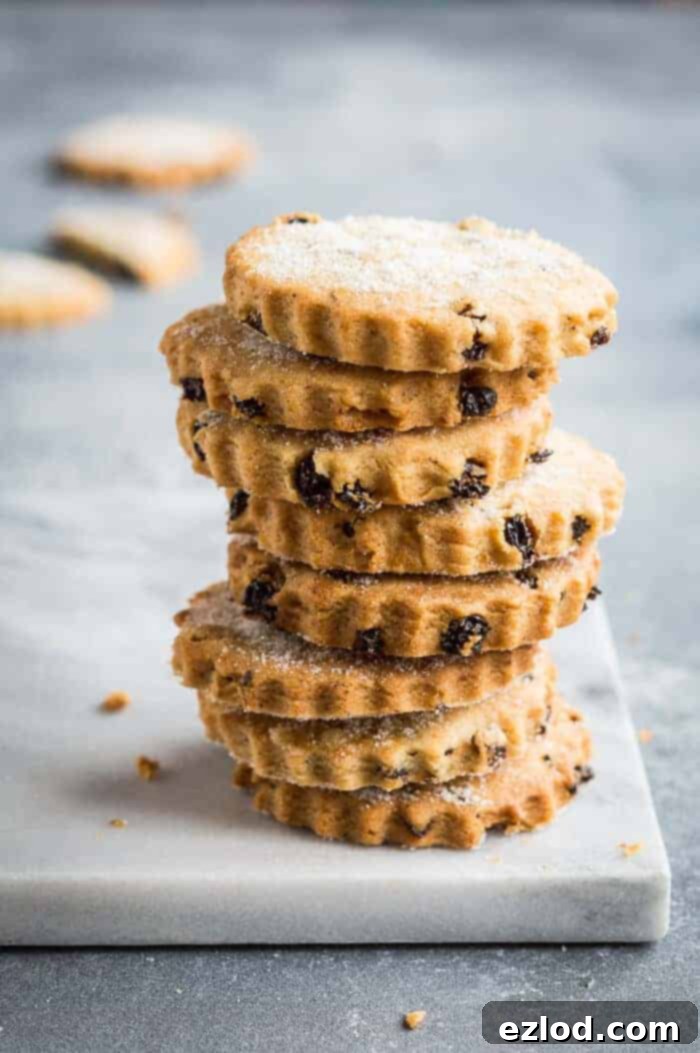Delightful Vegan Easter Biscuits: A Simple & Delicious West Country Tradition (Dairy-Free Recipe)
Discover the joy of baking these exquisite Vegan Easter Biscuits – a delightful plant-based rendition of the beloved traditional West Country treat. These crisp, lightly spiced cookies, dotted with sweet currants and brightened with a hint of lemon, are not only irresistibly moreish but also incredibly quick and easy to prepare.
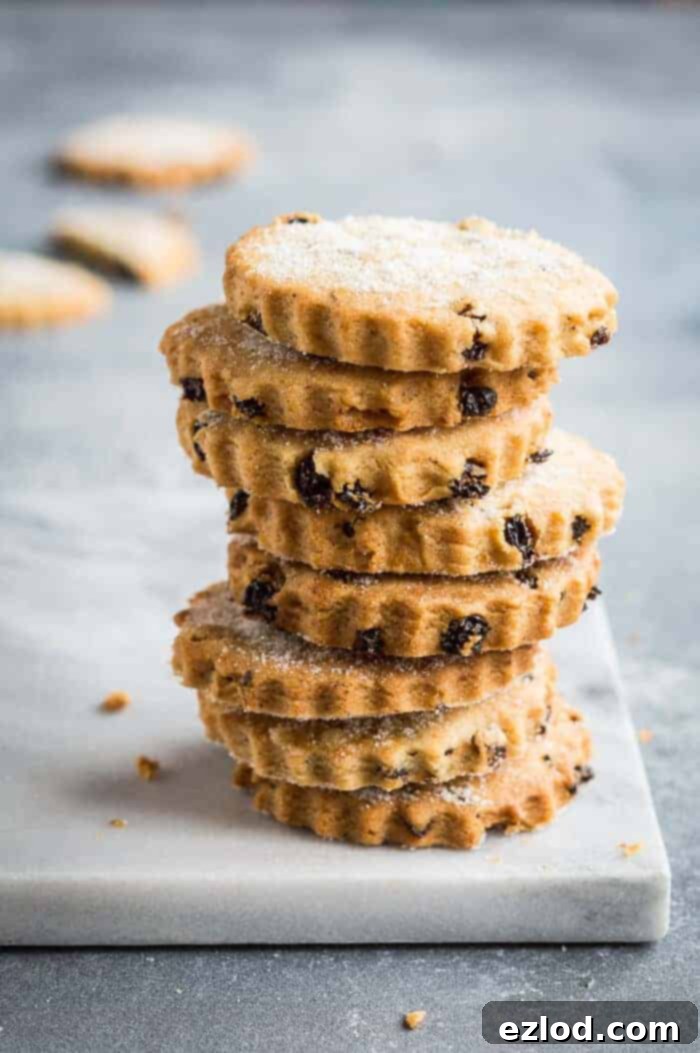
Easter, for many, is a time of renewal, spring blooms, and, of course, delicious food. While hot cross buns and chocolate eggs often steal the spotlight, there’s a rich tapestry of traditional treats waiting to be explored. On this blog, my collection of Easter recipes has been modest, typically revolving around the classics. However, that’s all about to change as we delve into the wonderful world of Easter baking, starting with a true gem from the West Country of England.
These Vegan Easter Biscuits are my plant-based take on a cherished tradition. Historically, these spiced, fruit-studded biscuits were given to guests on Easter Sunday, symbolizing hospitality and celebration. The original recipe, like many traditional bakes, relies on eggs, butter, and milk. But fear not! I’ve meticulously re-worked Mary Berry’s classic recipe to create a version that is completely vegan, dairy-free, and egg-free, yet loses absolutely none of its delicious charm and crisp texture.
What makes these vegan Easter cookies even more appealing is their incredible ease and speed of preparation. Unlike many cookie doughs that demand chilling, this recipe allows you to go from mixing bowl to baked perfection in under half an hour. Imagine fresh, warm, lightly spiced biscuits ready to enjoy with your Easter tea or coffee in no time – it’s baking magic!
Why Choose Vegan Easter Biscuits?
Opting for a vegan version of these traditional Easter treats isn’t just about catering to a plant-based diet. It’s about inclusivity, health, and a mindful approach to baking. For those with dairy or egg allergies, or anyone looking to reduce their animal product consumption, these biscuits offer a perfect solution without compromising on flavor or authenticity. They prove that you can enjoy classic recipes with a modern twist, making them accessible to everyone at your Easter table. Plus, the plant-based ingredients often lend themselves to a wonderfully tender crumb and crisp finish, making these a truly delightful surprise for all.
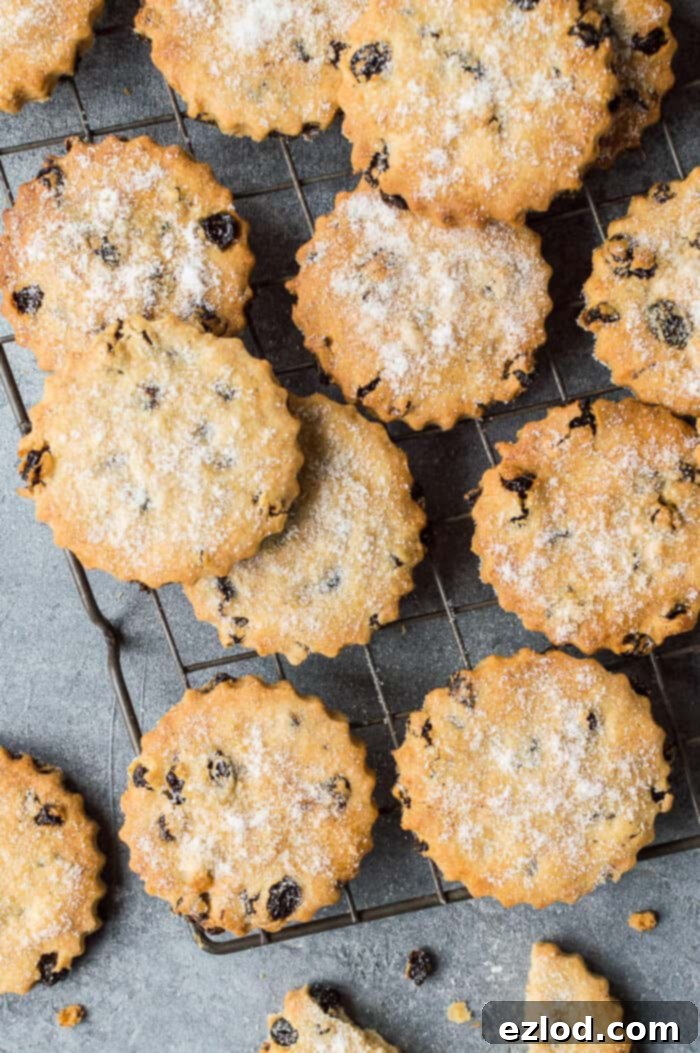
The Charm of West Country Easter Biscuits
The traditional West Country Easter biscuit is renowned for its unique combination of subtle spice, tart lemon zest, and plump currants, all encased in a satisfyingly crisp cookie. This humble biscuit holds a special place in British culinary heritage, particularly in counties like Somerset, Devon, and Cornwall. The inclusion of currants is particularly notable, harking back to a time when dried fruits were prized ingredients. The delicate balance of sweet, spicy, and citrusy notes makes them incredibly appealing and distinct from other Easter bakes. My vegan adaptation embraces all these core characteristics, ensuring that the spirit and taste of this classic are beautifully preserved in a modern, plant-friendly format.
How To Make These Irresistible Vegan Easter Biscuits:
(For a complete list of ingredients and detailed, step-by-step instructions, please refer to the comprehensive recipe card provided below.)
Step 1: Creaming the Vegan Butter and Sugar
Begin your baking journey by combining softened vegan butter (or margarine), caster sugar, and fresh lemon zest in a mixing bowl. Whisk these ingredients together until the mixture is light, fluffy, and beautifully creamy. This creaming process incorporates air, which is crucial for achieving that desirable crisp texture in your finished biscuits. Next, carefully whisk in the cornflour (also known as cornstarch in some regions), baking powder, and your chosen mixed spice (or pumpkin spice for an equally warming flavor profile). These dry ingredients are key to the structure and signature taste of the biscuits.
Step 2: Forming the Dough
With your wet ingredients expertly combined, it’s time to introduce the plain (all-purpose) flour and the juicy currants. Use a wooden spoon or a spatula to gently mix everything together. The goal here is to combine the ingredients without overmixing, which can lead to tough biscuits. Gradually, add just enough non-dairy milk, a tablespoon at a time, until the mixture comes together to form a cohesive, pliable ball of dough. The exact amount of milk may vary slightly depending on the absorbency of your flour and the consistency of your vegan butter, so add it slowly until the dough is just right – not too sticky, not too dry.
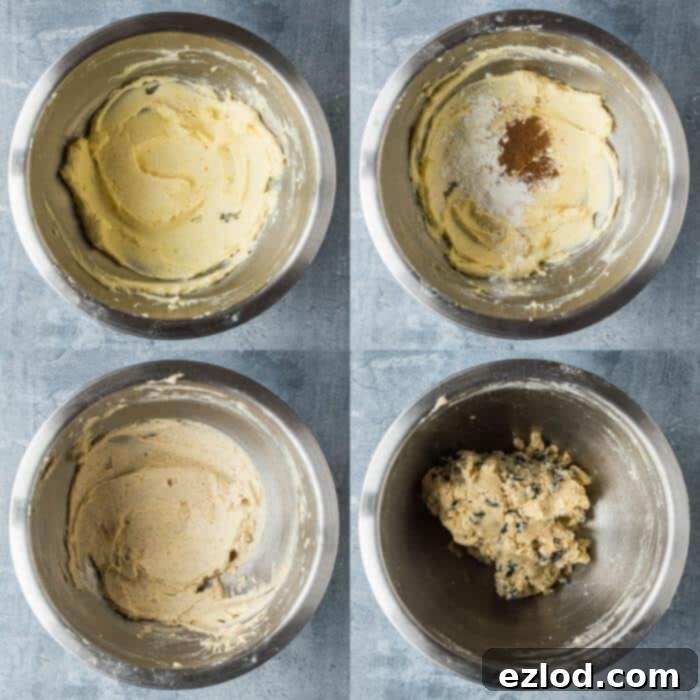
Step 3: Rolling and Cutting
Lightly flour your work surface to prevent sticking. Place your ball of dough onto the floured surface and roll it out evenly to a thickness of approximately 5mm (or about 1/4 inch). Consistency in thickness is important for even baking. Using a fluted 6cm round cutter, cut out as many biscuit rounds as you can from the rolled dough. Collect the dough scraps, gently bring them together, knead very briefly just to combine (again, avoid overworking the dough), and then re-roll and cut out more biscuits until all the dough is used.
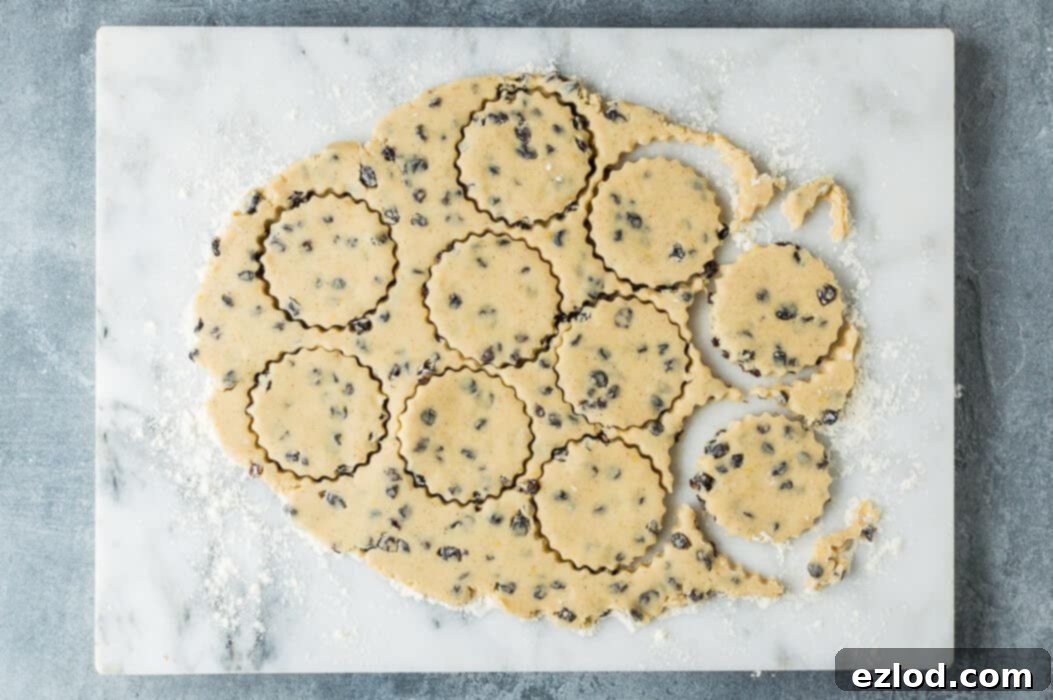
Step 4: Baking and Glazing
Arrange the cut biscuits spaced apart on two baking sheets that you’ve lined with baking parchment. This prevents sticking and ensures even heat distribution. Bake them in a preheated oven for an initial ten minutes. While they are baking, prepare your simple glaze: mix together the maple syrup and non-dairy milk in a small bowl. This glaze will add a beautiful sheen and a touch of extra sweetness. After the first ten minutes, carefully remove the biscuits from the oven. Lightly brush the tops of each biscuit with the maple syrup mixture and then generously sprinkle them with caster or granulated sugar. Return the biscuits to the oven for another five minutes, or until they turn a pale golden color and are cooked through. The second bake helps the sugar topping to set and caramelize slightly.
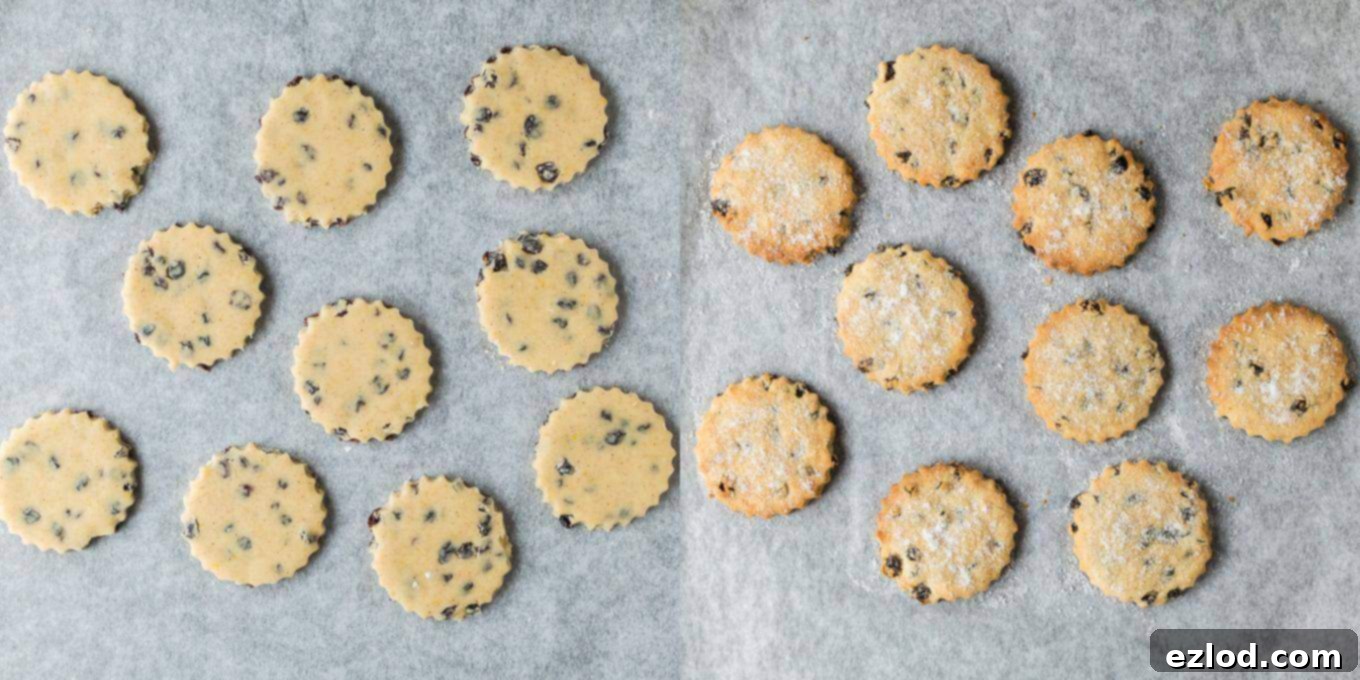
Once baked to perfection, transfer your golden vegan Easter biscuits to a wire rack to cool completely. This allows air to circulate, maintaining their crispness. Once cooled, they are ready to be enjoyed or stored for later indulgence.
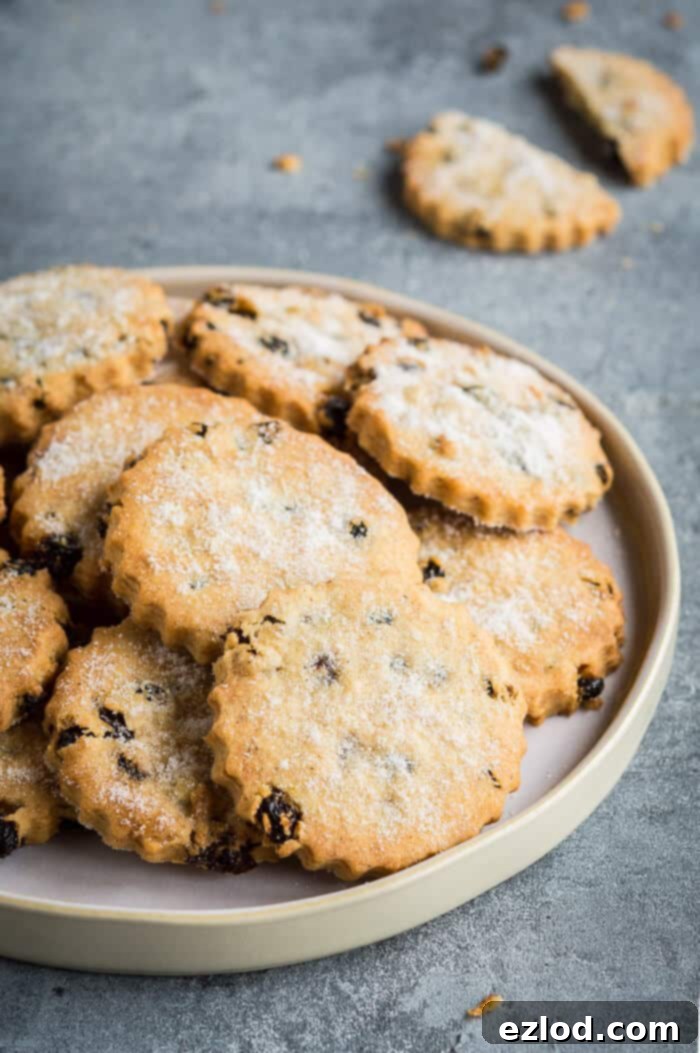
How Long Will These Vegan Easter Biscuits Keep?
One of the many advantages of these delightful vegan Easter biscuits is their excellent shelf life. Once completely cooled, they can be stored in an airtight container at room temperature for up to two weeks. This makes them perfect for preparing ahead of time for your Easter celebrations or for gifting to friends and family. The airtight seal is crucial for maintaining their crisp texture and preventing them from going stale.
A Word On Vegan ‘Butter’ for Baking:
The choice of vegan butter substitute is incredibly important for the success of these vegan Easter biscuits, and indeed for many vegan baking recipes. Not all vegan “butters” are created equal, especially when it comes to baking. The spreadable varieties that come in tubs typically have a lower fat content and a higher water content. While these are fine for spreading on toast, they can lead to overly tough, chewy, or even crumbly biscuits and pastries, as they don’t provide the richness and structure needed for a good bake.
For best results, always opt for a vegan butter that comes in a solid block format. These block butters are specifically formulated to mimic the fat content and texture of traditional dairy butter, making them ideal for baking. I personally highly recommend Naturli vegan block, which is readily available in many supermarkets like Sainsbury’s. Other excellent choices include Stork block (look for the one specifically labelled as “best for pastry” or “baking block”) or Vitalite block (again, ensure it’s the block, not the tub). For those in the US, Earth Balance buttery sticks are widely considered the correct and most reliable product to use for achieving consistent, delicious results in recipes like this one. Using the right fat will ensure your vegan Easter biscuits are wonderfully crisp, tender, and melt-in-your-mouth delicious.
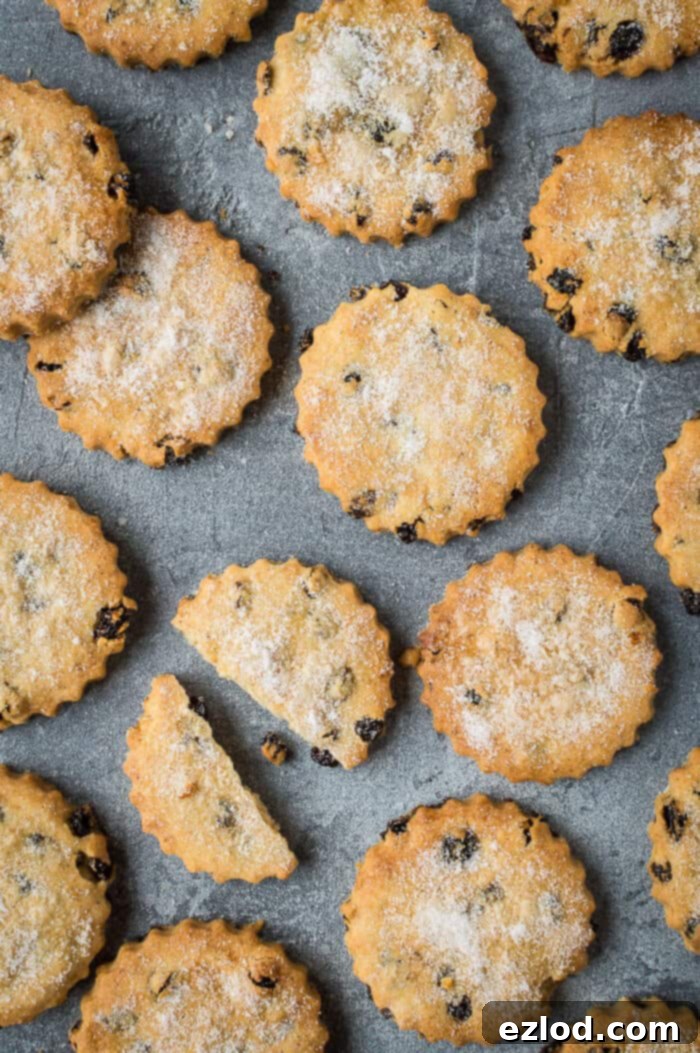
Tips for Perfect Vegan Easter Biscuits Every Time
- Ensure Vegan Butter is Softened: For proper creaming, your block vegan butter should be at room temperature, soft enough to easily indent with a finger, but not melted.
- Don’t Overmix the Dough: Once the flour and currants are added, mix just until combined. Overmixing develops the gluten in the flour, leading to tough biscuits.
- Roll Evenly: Aim for a consistent dough thickness (5mm/1/4 inch) to ensure all biscuits bake evenly and achieve the same crisp texture.
- Avoid Overbaking: Keep a close eye on your biscuits during the final minutes. They should be pale golden. Overbaking can make them dry and excessively crunchy.
- Adjust Spices to Taste: Feel free to increase or decrease the mixed spice based on your personal preference. A little extra can add a wonderful warmth.
- Fresh Lemon Zest is Key: Use fresh lemon zest for the brightest, most fragrant citrus notes. Bottled lemon zest won’t give the same vibrant flavor.
Variations & Customizations
While the traditional recipe is perfect as is, you can always experiment with these vegan Easter biscuits to suit your taste or what you have on hand:
- Dried Fruits: Instead of currants, try using small raisins, finely chopped sultanas, or even dried cranberries for a different fruity twist.
- Spice Profile: If you don’t have mixed spice, a combination of cinnamon, nutmeg, and a tiny pinch of ground cloves makes an excellent substitute. Or, go bold with ginger and cardamom!
- Citrus Zest: Orange zest can be used in place of lemon zest for a sweeter, more aromatic biscuit.
- Glaze Options: For a simpler finish, a dusting of powdered sugar after cooling is lovely. You could also make a quick lemon glaze by mixing powdered sugar with a tiny bit of lemon juice.
Frequently Asked Questions (FAQ)
Here are some common questions you might have about making these delicious vegan Easter biscuits:
Q: Can I use different dried fruits in these biscuits?
A: Absolutely! While currants are traditional, you can substitute them with an equal amount of small raisins, finely chopped dried cranberries, or sultanas. Just ensure they are small enough to distribute evenly in the dough.
Q: Is it possible to make these biscuits gluten-free?
A: I haven’t specifically tested a gluten-free version of this recipe, but you could try substituting the plain flour with a good quality 1:1 gluten-free baking flour blend that contains xanthan gum. Keep in mind that the texture might be slightly different, and you may need to adjust the amount of non-dairy milk slightly. Always check the instructions for your specific GF flour blend.
Q: Can I freeze the dough or the baked biscuits?
A: Yes, you can! The unbaked dough can be wrapped tightly in plastic wrap and frozen for up to 3 months. Thaw it in the refrigerator overnight before rolling and baking. Baked biscuits can also be frozen for up to 2-3 months in an airtight container. Thaw them at room temperature, and if you like, you can warm them briefly in a low oven for a fresh-baked feel.
Q: What is the difference between “mixed spice” and “pumpkin spice”?
A: Both are blends of warming spices, but they have different traditional compositions. “Mixed spice” (common in the UK) typically includes cinnamon, coriander, caraway, nutmeg, ginger, and cloves. “Pumpkin spice” (common in North America) usually contains cinnamon, ginger, nutmeg, and allspice, and often cloves. They are generally interchangeable in recipes like this for a similar warming effect, but mixed spice can have a slightly more complex, earthy flavor due to the coriander and caraway.
Q: Why is it so important to use block vegan butter instead of spreadable tub margarine?
A: Block vegan butter has a higher fat content and lower water content, making its consistency very similar to dairy butter. This is crucial for creating the right dough texture, which results in crisp, tender biscuits. Spreadable margarines often contain more water, which can lead to tough, chewy, or overly dry and crumbly results because they don’t provide enough fat for richness and flakiness.
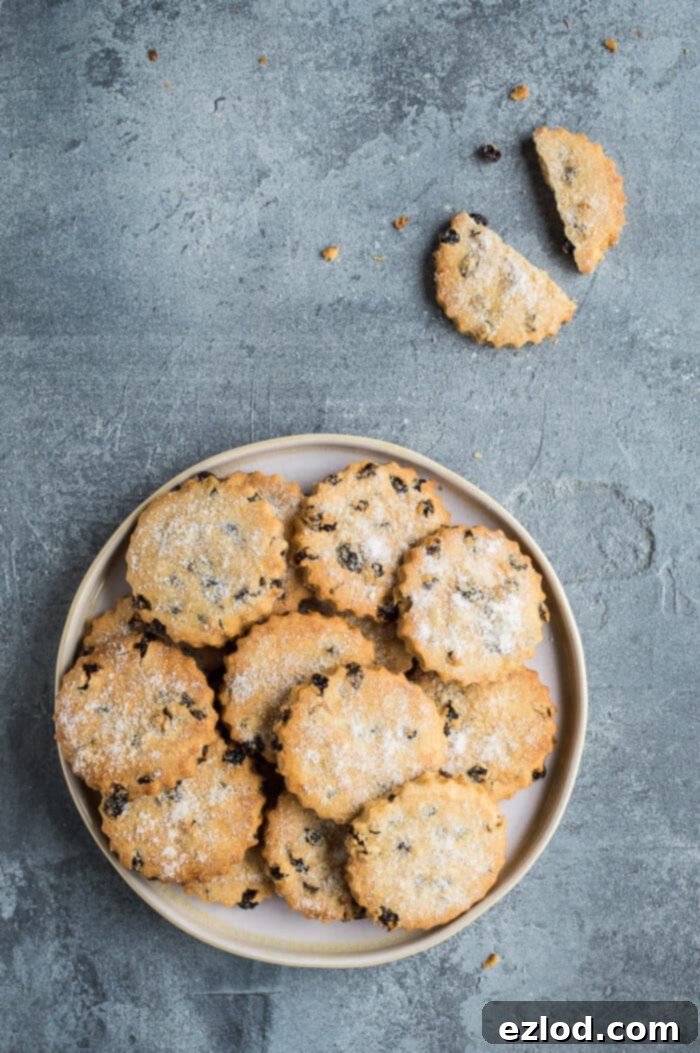
If you tried this delightful recipe, we’d love to see your creations! Tag @domestic_gothess on Instagram and use the hashtag #domesticgothess to share your vegan Easter biscuits with our community!
*All images and content on Domestic Gothess are copyright protected. If you wish to share this recipe, please do so by using the provided share buttons. Please refrain from screenshotting or posting the recipe or content in its entirety.*

Print
Vegan Easter Biscuits
Ingredients
Dough:
- 110 g (scant ½ cup) vegan butter/margarine (the solid stick kind, NOT spreadable) softened
- 80 g (⅓ cup + 1 Tbsp) caster (superfine) sugar
- finely grated zest of 1 lemon
- 10 g (1 Tbsp) cornflour (cornstarch)
- ½ tsp baking powder
- ½ tsp mixed spice (pumpkin spice)
- 200 g (1 + ⅔ cup) plain (all-purpose) flour
- 70 g (2.5 oz) currants
- 1-2 Tbsp non-dairy milk
Glaze:
- 2 tsp maple syrup
- 3 tsp milk
- caster or granulated sugar for sprinkling
Instructions
-
Preheat your oven to 200C/400F/gas mark 6. Prepare two baking sheets by lining them with baking parchment. This ensures your biscuits won’t stick and will brown evenly.
-
In a large mixing bowl, thoroughly whisk together the softened vegan butter/margarine, caster sugar, and the vibrant lemon zest until the mixture becomes wonderfully smooth, light, and creamy. This step is vital for incorporating air and creating a tender biscuit.
-
Next, add the cornflour (cornstarch), baking powder, and the aromatic mixed spice (or pumpkin spice for a similar warm flavor). Whisk these into the creamy mixture until just combined, ensuring there are no lumps of dry ingredients.
-
Now, gently fold in the plain flour and the plump currants. Using a wooden spoon or spatula, mix everything together until it starts to clump. Gradually add the non-dairy milk, one tablespoon at a time, mixing until the dough comes together into a soft, manageable ball. Be careful not to add too much milk; the dough should be firm but pliable.
-
Lightly flour your work surface and roll out the dough to an even thickness of approximately 5mm (or 1/4 inch). Use a fluted 6cm round cutter to cut out as many biscuit rounds as possible. Gather the dough scraps, knead them very briefly to bring them together, then re-roll and cut out additional biscuits. This minimizes waste and maximizes your batch!
-
Place the cut biscuits onto your prepared baking sheets, ensuring they are spaced adequately apart to allow for even baking. Bake them in the preheated oven for ten minutes. While they are in the oven, whisk together the maple syrup and non-dairy milk in a small bowl to create your glaze.
-
After the initial bake, carefully remove the biscuits from the oven. Lightly brush the tops of each biscuit with the maple syrup mixture using a pastry brush, then immediately sprinkle them generously with caster or granulated sugar. Return the biscuits to the oven for a further five minutes, or until they are beautifully pale golden and cooked through to perfection.
-
Once baked, transfer the warm vegan Easter biscuits to a wire rack. Allow them to cool completely on the rack; this helps them achieve their desired crisp texture. Store any leftover biscuits in an airtight container to keep them fresh for longer. Enjoy your homemade, delightful Easter treats!
Notes
Any variety that comes in a solid block should be fine. I love Naturli vegan block which is available from Sainsbury’s; but Stork block (labelled as best for pastry) will also work well. In the US I believe that Earth Balance buttery sticks would be the correct product to use.
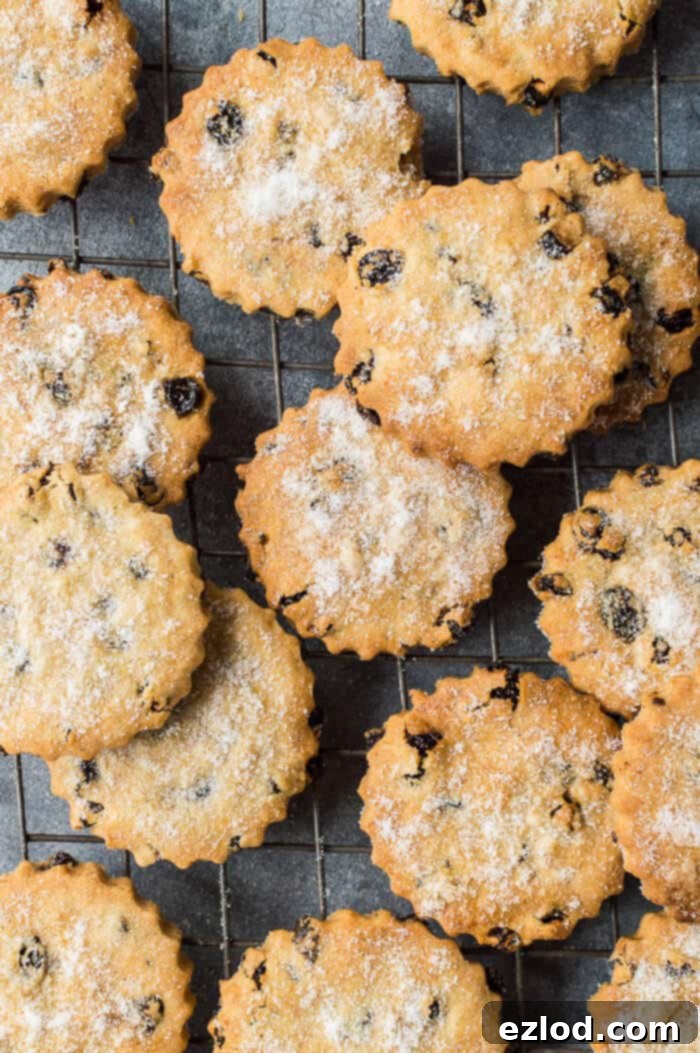
More Vegan Easter Recipes to Explore:
If you’re looking to expand your vegan Easter baking repertoire, here are some other fantastic recipes from the blog that you might enjoy:
- Vegan Hot Cross Buns: A classic Easter staple, soft and spiced.
- Chocolate Orange Hot Cross Buns (vegan option): A delightful twist on the traditional.
- Vegan Simnel Cake: The iconic fruit cake with a marzipan topping, perfect for Easter.
- Vegan Carrot Layer Cake: A moist and flavorful cake, great for any spring celebration.
- Easy Vegan Chocolate Cake: A crowd-pleasing dessert that’s simple to make.
- No-Bake Chocolate Stem Ginger Tart (vegan): An elegant and effortless dessert.
- Vegan Steamed Chocolate Pudding: A rich and comforting dessert.
- Orange and Almond Cake with Chocolate Buttercream (vegan): A decadent and zesty combination.
- Vegan Vanilla Cake with Berries and Jam: A classic cake perfect for any occasion.
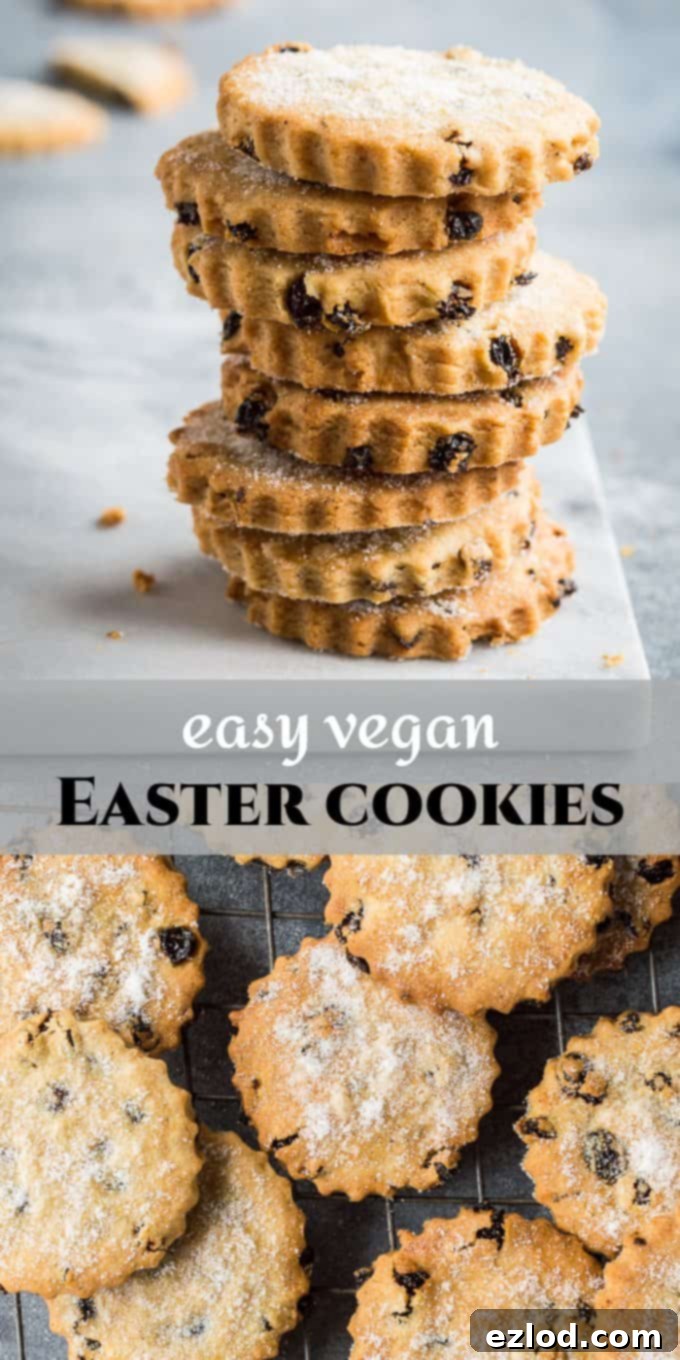
I hope you enjoy baking these delightful vegan Easter biscuits as much as I do. They are a wonderful way to bring a piece of West Country tradition into your home, made accessible for everyone to enjoy. Happy Easter baking!
